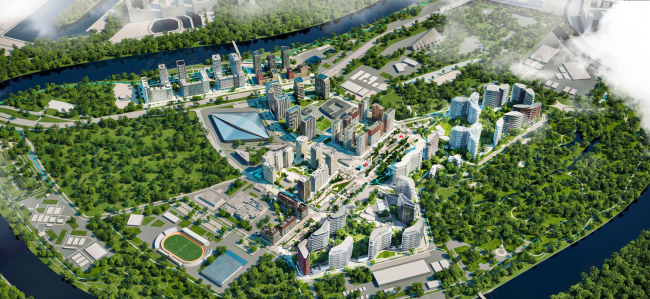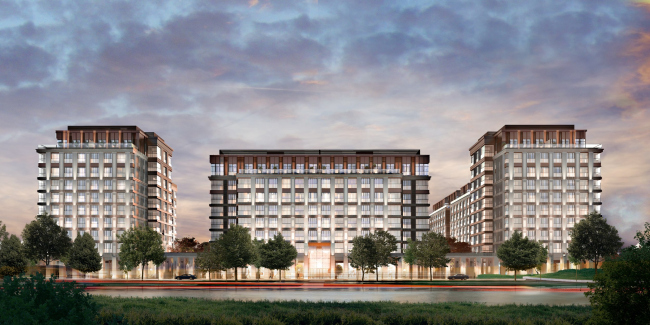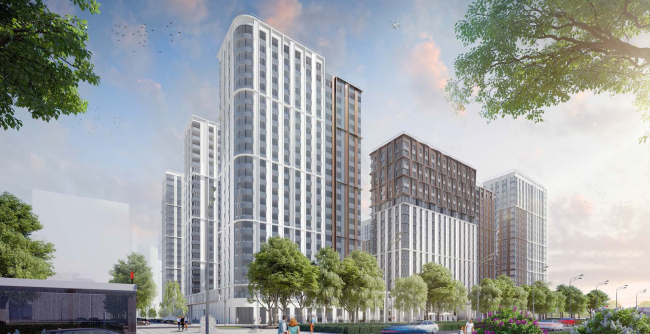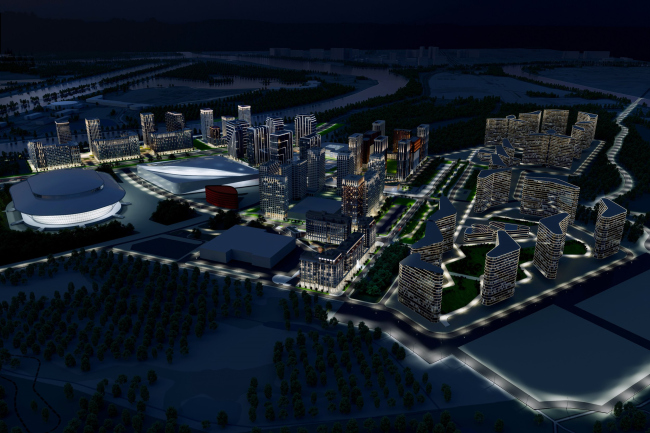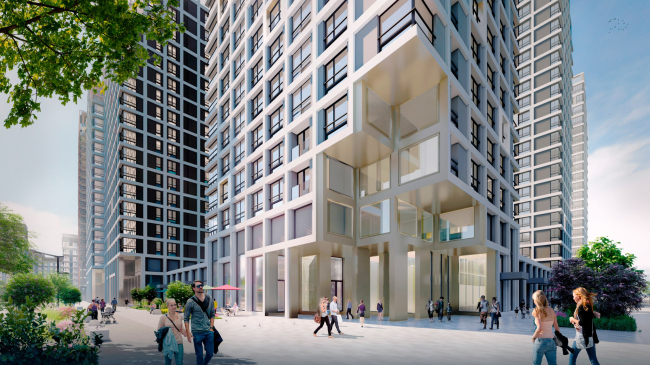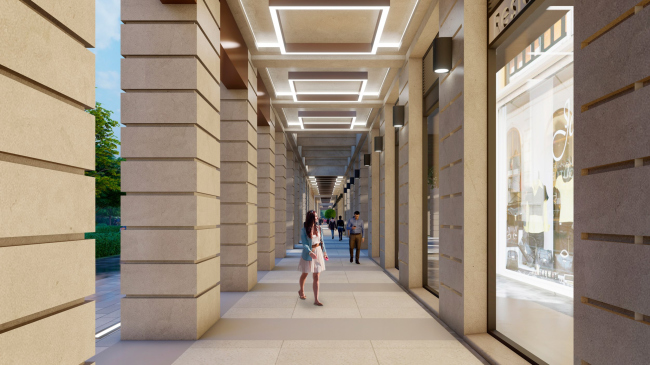|
Published on Archi.ru (https://archi.ru) |
|
| 12.05.2023 | |
|
Julius Borisov: “The “Island” housing complex is a unique project – we took it on with interest and excitement” |
|
|
Julia Tarabarina |
|
| Architect: | |
| Yuliy Borisov | |
| Studio: | |
| UNK | |
| ASADOV architects | |
| Laptev and Partners | |
|
One of the largest housing projects of today’s Moscow – the “Ostrov” (“Island”) housing complex built by Donstroy – is now being actively built in the Mnevniky Floodplain. They are planning to build about 1.5M square meters of housing on an area of almost 40 hectares. We are beginning to examine this project– first of all, we are talking to Julius Borisov, the head of the architectural company UNK, which works with most of the residential blocks in this grand-scale project, as well as with the landscaping part; the company even proposed a single design code for the entire territory. The residential complex “Ostrov” in Mnevnikovskaya Floodplain is a giant project of Donstroy Invest company. However, the floodplain itself is even bigger – the future residential complex does not occupy it entirely, but is located in the middle part of the drop-shaped territory surrounded by a bend of the Moskva River. There are overgrown green areas on the sides, future parks and several construction sites. The “Island” is adjacent to the river in the northern part, where two blocks, 1 and 4, are located near the water; to the west of the territory several sports facilities have either already been built or are under construction, including the Tatiana Navka Ice Palace, a building with an artificial wave and an outdoor stadium. In the northeastern part of the floodplain, near the Mnevniki subway station, plans for the Parliamentary Center, which has been talked about since 2015, seem to still be lukewarm; but little is known. Ostrov housing complexCopyright: © UNKIn 2020, the British company LDA+ proposed a master plan for the development of the area (we will remind you at this point that in 2015 they also worked with the original plan of “Serp i Molot”). Then, however, the economic performance indicators of the future residential complex grew significantly, and the master plan was no longer relevant. The development of the area began with two blocks: number 1 in the northwestern part near the river (it was designed by APEX) and number 2 in the center (authored by Gorproekt and Filip Nikandrov). Then, around the end of 2021, Julius Borisov’s UNK was invited to comprehend the area as a whole and to design the next five blocks. The task was a large-scale one, and they had only nine months to complete it. At first, the project was developing in secrecy, with only individual pictures “leaking out” through the mailing lists of industry agencies. Now we can talk about it relatively freely, sales are open, presentations have been made. Since the project is very big and UNK worked not only on the architecture of the districts, but also proposed the entire public landscape and the concept of evening lighting – we decided to talk about it in a mixed format. We will start with an interview with Julius Borisov and talk about the individual projects, one of which covers the landscape solutions and the other one the whole complex lighting – they were developed by UNK Landscape and UNK Lighting respectively; we also plan to cover some of the city blocks individually. Archi.ru What was the hardest part? Julius Borisov, UNK: The hardest part was the rate of our work, which required self-organization skills we never thought we possessed. Another difficulty was the gigantic scale – this is a city area the size of an average European city. In a word, this was a unique task, and we love any unconventional tasks, so we took it on with interest and even with excitement. In addition, I have to say that I’m a fan of the Khamovniki and Luzhniki districts. I live there, I grew up there, I worked on the Aquatics and Martial Arts Center... It seems to me that the Khamovniki floodplain is similar in many ways to the place that we worked with, of course, with the significant difference that it is not built up yet. It is a bend of the Moskva River, from here there is a splendid view of the other side, one bank is flat, the other is steep. I studied the development history of Khamovniki, there are a lot of interesting coincidences. On the other hand, Mnevniki is a natural area – there are not many of them left in Moscow. It required a very careful approach, and that is also a unique task. What is the main idea of your project? Our main message is that we left nothing to chance, no part of our project is accidental. Our other message is partially opposite to the main one: you cannot come down to standardization and standardized solutions. We tried to balance on the verge between variations and a common design code – we did not look to create a semblance of a historical city, which has developed consistently and for a long time, we do very well realize that in our case this is not practicable – but we did want to avoid monotony and create a recognizable “face” of this area. The idea to invite other architectural companies to work on the project – was it yours or was it your client’s? Who selected coauthors? Did you get along well? The idea was ours, and the client supported it. I think this is the right approach globally, we are in line with the right trends, and we know a lot of such joint projects. I chose the partners; we have known each other for a long time; besides, we proceeded from the current availability of our colleagues. I must say that because we had to work very quickly and also because we all know each other well, the interaction was not particularly formalized; we worked as a team and there was not much difference between “external” and “internal”. "Ostrov« (»Island") housing complex. Block #4Copyright: © Laptev and partners / provided by UNK"Ostrov« (»Island") housing complex. Block #5Copyright: © ASADOV Architects / provided by the press service of MoskomarkhitekturaUltimately, however, it was us who was responsible for the end result; we defined the main parameters, the massing, the general principles, and interacted closely and constantly. There were, of course, improvisations, but my “dictatorship” was quite rigid. What other means did you use to achieve diversity, and how did you implement common features? One thing that was helpful was the diversity of typology; each block had its own parameters in terms of height and density. For example, Block 3 is a high-end residential development: it is low-rise and it has a higher class of housing. "Ostrov« (»Island") housing complex. Block #3Copyright: © UNKHere, in response to a request from potential customers and our client, we chose the theme of a conditional “Versailles in a modern London version”: the house is symmetrical, its facades are distinguished by a great deal of complexity, although without direct stylization, it has an attic floor with terraces, it combines fiber concrete of limestone color with cladding of copper shade – it is not a powder coating, we went through about 80 samples, and we selected the shade and texture so that the surface resembles natural copper and was durable; I purposefully flew to London, and looked at the Foster building… 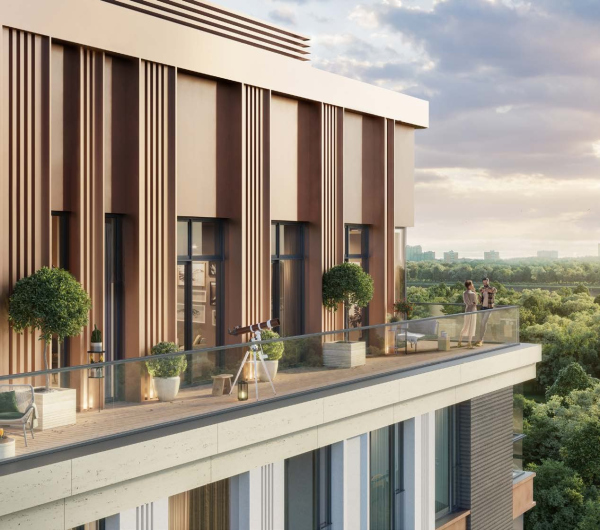 "Ostrov« (»Island") housing complex. Block #3Copyright: © UNK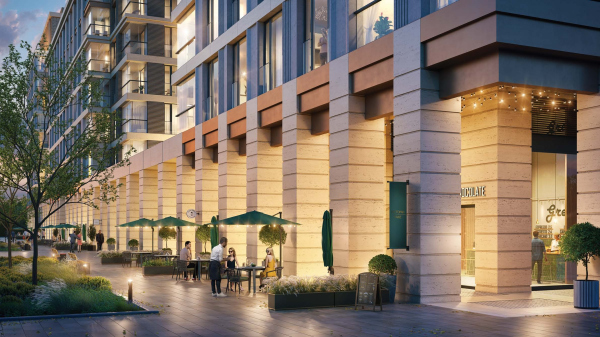 "Ostrov« (»Island") housing complex. Block #3Copyright: © UNK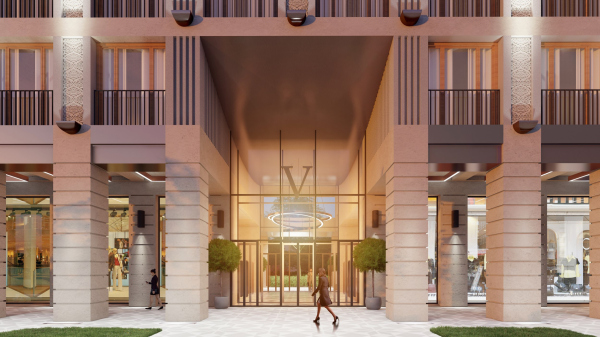 "Ostrov« (»Island") housing complex. Block #3Copyright: © UNK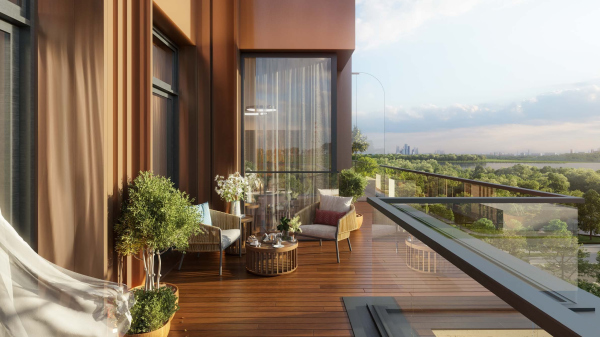 "Ostrov« (»Island") housing complex. Block #3Copyright: © UNK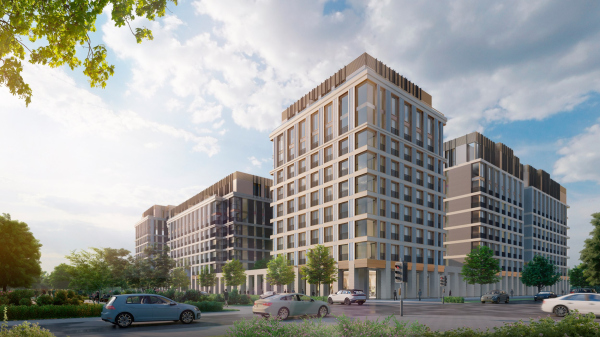 "Ostrov« (»Island") housing complex. Block #3Copyright: © UNK "Ostrov« (»Island") housing complex. Block #3Copyright: © UNKThe house allowed us to diversify the palette of the complex as a whole, it served as a kind of starting point. In all the other neighborhoods, both relatively reserved and futuristic, we used light beige, white, black and copper tones throughout. We wanted a kind of “musical theme” within which each block develops a story of its own. For example, Block 6, which is located near Block 3, yet is closer to the city center and the metro station, is very dense, and the housing in it is less expensive than in the neighboring high-end house; you could say that this is designed for young people and young families. In addition, it has a kindergarten in it. We decided to develop the “gameplay” theme – this is how these large cutaways appeared, very much in the spirit of LEGO or Minecraft. These cutaways are situated on the “sight beams”, and they help to reveal a few beautiful views. The silhouette becomes more sophisticated, this helps to avoid excessive simplicity and the “crate” effect. I don’t like crates – a building must have a recognizable image. 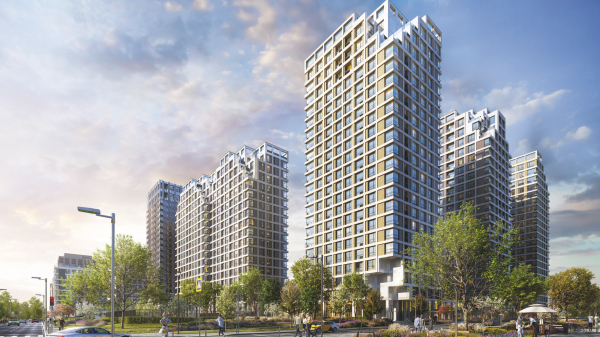 "Ostrov« (»Island") housing complex. Block #6Copyright: © UNK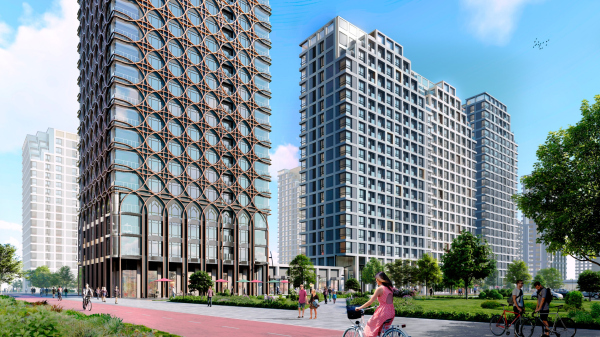 "Ostrov« (»Island") housing complex. Block #6Copyright: © UNK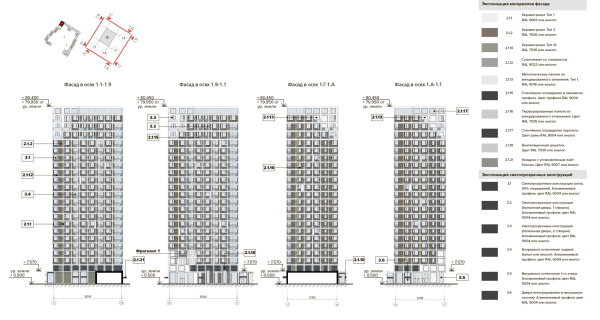 "Ostrov« (»Island") housing complex. Block #6. The facades of Building 1 in axes 1.1-1.9, 1.9-1.1, 1.Ŕ-1.Ă, 1.Ă-1.ŔCopyright: © UNK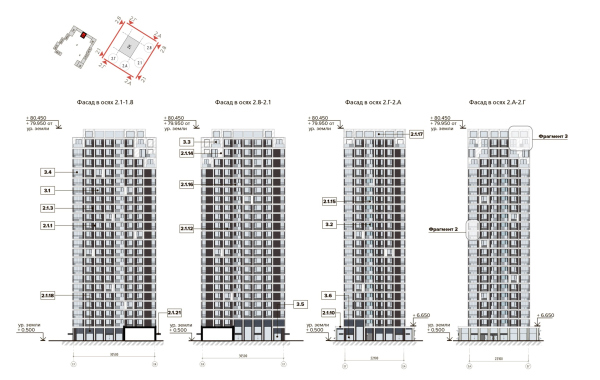 "Ostrov« (»Island") housing complex. Block #6. The facades of Building 1 in axes 2.1-2.8, 2.8-2.1, 2.Ă-2.Ŕ, 2.Ŕ-2.ĂCopyright: © UNK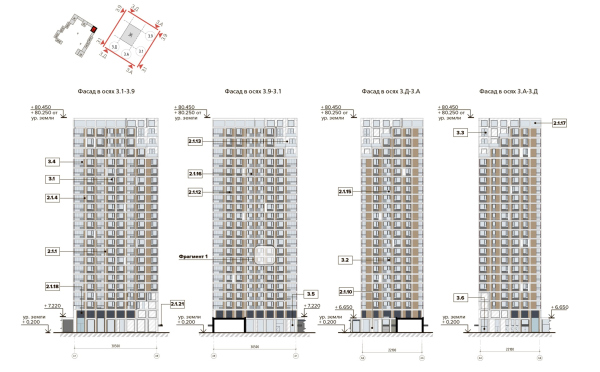 "Ostrov« (»Island") housing complex. Block #6. The facades of Building 1 in axes 3.1-3.9, 3.9-3.1, 3.Ä-3.Ŕ, 3.Ŕ-3.ÄCopyright: © UNK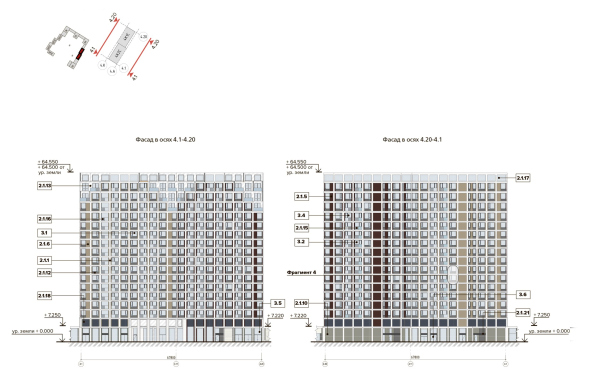 "Ostrov« (»Island") housing complex. Block #6. The facades of Building 1 in axes 4.1-4.20, 4.20-4.1Copyright: © UNK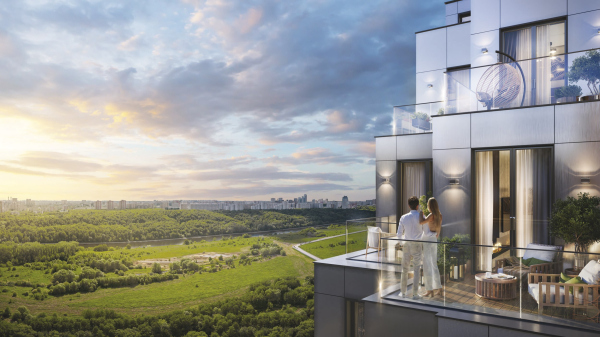 "Ostrov« (»Island") housing complex. Block #6Copyright: © UNK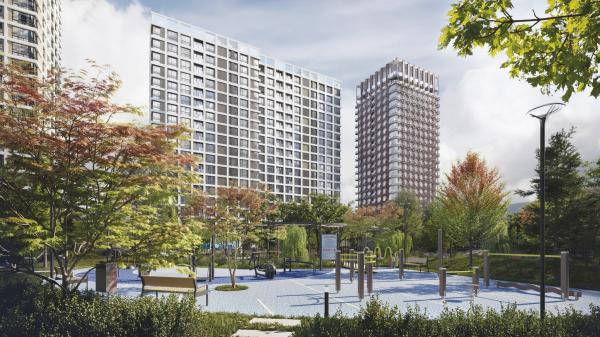 "Ostrov« (»Island") housing complex. Block #6Copyright: © UNKHowever, the neighboring quarters, the third and sixth, were very different, and I had to tie them together somehow... Then I drew the tallest tower of the sixth quarter myself. Its scale and considerable height “belong” to the sixth quarter, and the detailing of the openwork copper facade, as well as the “crown” in the upper part, line up with the high-end club house I mentioned earlier, its elaboration and its attic. For some, it evokes classical associations, for others oriental ones. "Ostrov« (»Island") housing complex. Block #6Copyright: © UNK"Ostrov« (»Island") housing complex. Block #6Copyright: © UNK"Ostrov« (»Island") housing complex. Block #5Copyright: © ASADOV Architects / provided by the press service of MoskomarkhitekturaAnother task was to coordinate the pattern of the openwork copper lattice with the grid of windows – it took some effort, but we did it. And on the opposite side we also managed to build an ensemble, which is not often the case in modern urban development. How exactly did you achieve that? According to the brief, the sixth block, which was designed by ASADOV architects, was to have a shopping mall in it. We searched for a solution for quite a long time, but we couldn’t find the right place for it. Help came from Alexander Asadov – he suggested that we rotate the shopping mall, placing it not parallel but perpendicular to the boulevard. Once we did that, everything fell into place: the rectangle of the mall occupied the space between the two central blocks, the sixth and fifth, and we put three towers at the ends of the two sites, facing each other. The result was a three-dimensional coherence, a choreographed urban planning solution, a real center, high-density and symmetrical, next to the subway station. "Ostrov« (»Island") housing complex. The concept of architectural lightingCopyright: © UNKIn addition, a very important role in integrating the space of the entire complex was played by the project lighting, the design code which we developed for the entire complex, and the landscape of the public areas – both projects were handled by companies belonging to the system of UNK, UNK Lighting and UNK Landscape. "Ostrov« (»Island") housing complex. Block #6Copyright: © UNKSpeaking about the landscape – is the central boulevard also a part of the housing complex? Why is it so straight? It is so straight because a subway line runs directly underneath it, and, as you may expect, this land is municipal – there are lots of boundaries there; the land that is closer to the buildings belongs to the complex, but the boulevard is municipal. But we did our best to visually smooth out the borders and make the boulevard an organic part of the complex. And we paid maximum attention to the part of the city that is perceived directly by a person, a pedestrian. We have a lot of galleries in the shopping streets, we have implemented a “dry feet” approach, which allows you to move within a block without getting your shoes wet. It should be easy and pleasant to walk in the city. "Ostrov« (»Island") housing complex. Block #3Copyright: © UNK"Ostrov« (»Island") housing complex. Block #3Copyright: © UNKHowever, the landscaping and lighting projects will best be described and explained by their authors, the leaders of the divisions. Is the Island housing complex your largest project so far? If you consider it as a single whole, then it is, especially if you speak about the project stage. We also have large-scale projects in Yuzhno-Sakhalinsk; they have large areas, but the sum of square meters in Ostrov is larger. |
|
